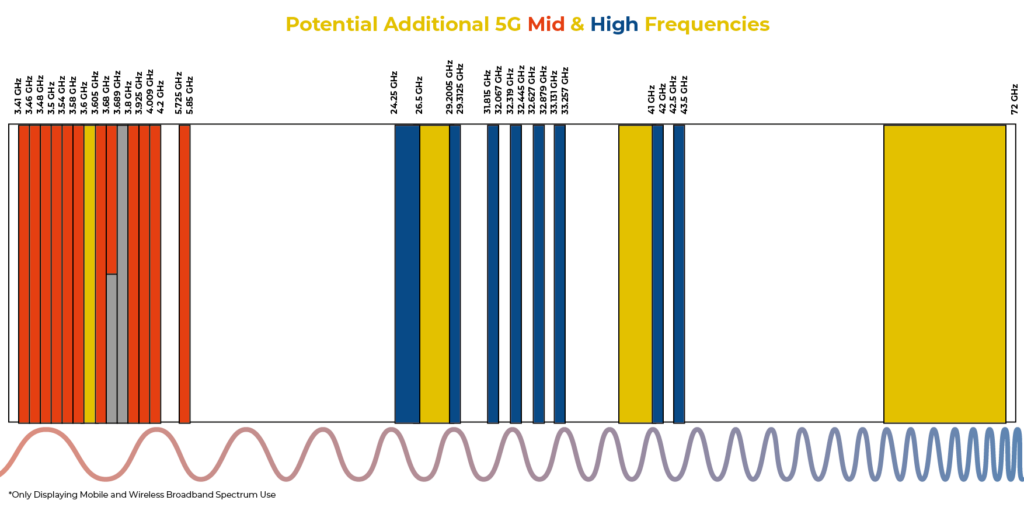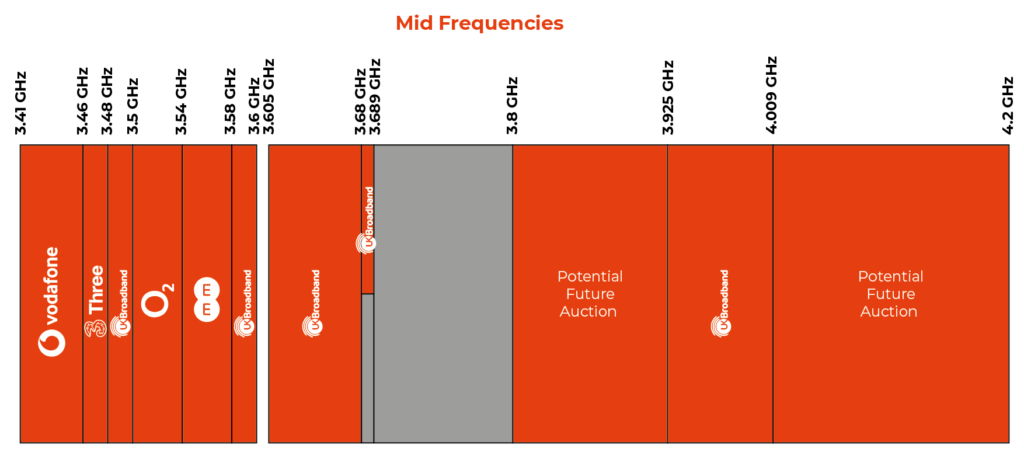Why is 5G Spectrum Mapping Important?
Rapidly growing data usage and its efficient applications is a growing challenge that 5G spectrum mapping helps visualise, empowering stakeholders to take practical actions to resolve issues.
5G spectrum mapping is a view of the availability and the congestion within the radio bands allocated for 5G usage.
Spectrum is a country-specific asset and owned by the state. The specific allocation and rate of use of the airwaves in the UK are overseen by Ofcom, which manages it and issues licenses accordingly.
5G networks are rolling out as part of the UK digital infrastructure evolution. Telecoms Operators and network providers such as BT, Vodafone, EE, Three and O2 have invested heavily in securing a specific spectrum to roll out to their customers. Major fibre cable infrastructure to support the UK 5G rollout is already well underway.
Radio Spectrum Range
The radio spectrum is used to carry information wirelessly for many vital services. Demand for access to the spectrum is high, and regulators ensure its efficient use for socio-economic benefits.
Specifically for communication, the radio spectrum ranges from 10kHz low-frequency waves through the Mhz mid-range into high-frequency waves at 100 GHz. Furthermore, the frequency of the waves affects the wavelengths. For example, lower frequencies can be over 30 km long, with higher frequencies being less than 3 mm in length.
In its entirety, the radio spectrum carries information wirelessly for everyday services ranging from television and radio broadcasting, mobile phones and Wi-Fi to communications systems for emergency services, GPS and radar.
The spectrum relates to finite radio frequencies allocated to telecoms operators and other sectors for communication over airwaves. As the spectrum gets more congested with different radio applications, it requires additional monitoring, adaptation, and good housekeeping to keep it functioning well.
Why Do Wavelengths Matter For 5G?
 5G Spectrum Mapping identifies the different frequencies used.
5G Spectrum Mapping identifies the different frequencies used.
Low Frequency Spectrum Wavelengths
Lower frequency provides more comprehensive coverage because they are low energy, allowing them to travel far distances and penetrate objects such as walls and buildings. This frequent can offer 5G services more easily including in the countryside as the information waves travel further.
However, the low-frequency spectrum is in limited supply. Resultantly, stakeholders who use spectrum have sought to acquire higher frequency bands to solve the capacity issues.
Low-frequency spectrum will support improved mobile data coverage and increased user experience. Ofcom auctioned some of the 700MHz band in 2019, and have attached certain criteria to this spectrums use.
Mid Frequency Spectrum Wavelengths
Mid-frequency spectrum is the sweet spot for 5G and the demand for new mobile services. 3.4-3.8 GHz is the primary band for 5G in Europe. This is due to offering increased capacity for mobile broadband over wide areas. Ofcom in the UK auctioned the 2.3 GHz and 3.4 GHz bands and 3.6-3.8 GHz bands for mobile services in 2019.
Ofcom also has the ability to increase sharing in the 3.8-4.2 GHz spectrum range for innovative new 5G uses.
High Frequency Spectrum Wavelengths
At the other end of the spectrum, high-frequency bands do not provide the same coverage, as walls and buildings stop waves from penetrating. High-frequency bands have much greater bandwidth availability, making it easier to flex across several broadcast bands leading to higher network capacity.
With every network upgrade from 2G, 3G, 4G (LTE) and now to 5G, the bandwidth has moved to allow for increased speeds and data flows. For example, UK 2G frequencies started around 2GHz, 3G around 2.4GHz, 4G moved up to 2.8GHz. With every incremental move, the wavelength gets shorter, allowing greater data transfers with higher speeds as relevant technology is enabled.
What Benefits Are There at the 5G Wavelength?
The 5G wavelength is a game-changer for wireless connectivity. 5G internet needs to deliver faster speeds at a higher capacity. 5G can offer mobile transfer speeds of 10-20 Gbps (that is 10,000 Mbps - 20,000 Mbps) and can overlap 1 million connected devices per square kilometre.
Also, at this 5G wavelength, you can achieve very low latency. Latency is the speed of communication between devices, and 5G can handle this in less than one millisecond, making it almost real-time. This low latency allows the development of new applications such as autonomous cars, mobile virtual reality or remote surgery.
Where Does 5G Sit Within the Spectrum?
The UK's 5G network will be built across various 'coverage' and 'capacity' layers. The coverage layer will provide 5G across the country, particularly in rural areas using spectrum in the 700 MHz band that propagates well. A capacity layer will be added to add capacity and speed in areas with higher population densities, using spectrum in the 3.3 GHz-4.2 GHz function range. This location is not a large amount of scope for all potential uses, so there is a need to offer this bandwidth's contiguous, monitored, and flexible service.
The contiguous range is essential for connection experience and scalability. It refers to a continuous range within the spectrum allocated to a particular provider. For example, by looking at the 5G spectrum mapping above, you can see that UK telecoms carriers have purchased 'blocks' of GHz for their use.
5G Wavelength is around 70mm to 90 mm in length, depending on frequency.
Eventually, more spectrum will be required to maintain a quality 5G service and meet demand, as further connected devices dominate our lives. Additional frequencies can be added in the 3.5 GHz, 26GHz, 40GHz and 66-71GHz ranges.
 5G Spectrum Mapping Future 5G Frequencies
5G Spectrum Mapping Future 5G Frequencies
The mobile industry is paying a substantial amount for the available spectrum to innovate new technologies and generate economic benefits and social benefits.
HOW MUCH DID OPERATORS PAY FOR ACCESS TO NEW 5G SPECTRUM?
A total of 200 MHz of available spectrum was bid for in Ofcom's auction which was split across low frequency and mid frequency bands:
80 MHz of spectrum was auctioned in the 700 MHz low-frequency band
The 700 MHz frequency airwaves are perfect to provide wide area coverage including connection in the countryside.
120 MHz of spectrum was auctioned in the 3.6-3.8 GHz Mid-Frequency band
These are the critical areas of the spectrum and form the primary band for 5G. They are capable of boosting mobile data capacity with the ability to carry lots of data-hungry connections simultaneously.
Four UK operators bid for access to the spectrum.
EE Limited
£475,000,000 for 2x10 MHz & 1x20MHz in the 700 MHz band and for 40 MHz in the 3.6-3.8 GHz band
Three (Hutchinson 3G UK)
£280,000,000 for 2x10 MHz in the 700 MHz band
o2 (Telefonica)
£448,000,000 for 2x10 MHz in the 700 MHz band and for 40 MHz in the 3.6-3.8 GHz band
Vodafone
£176,400,000 for 40 MHz in the 3.6-3.8 GHz band
Total revenue raised through the 5G spectrum Ofcom auction is £1,379,400,000.
 5G Spectrum Mapping Mid Frequency Carrier Graph
5G Spectrum Mapping Mid Frequency Carrier Graph
To put this amount in context, in 2000, the Ofcom 3G auction raised £22.5 billion (however it was for a larger amount of spectrum and considered over-value leading to significant industry financial problems).
The 4G spectrum auction in 2013 provided a significant increase over the 3G spectrum already in use and raised £2.4 billion.
Could 5G Spectrum Mapping Become Dynamic?
Emerging technologies require a significant amount of available, efficient spectrum, so identifying, defragmenting, sharing, moving, & sorting prime bands is essential.
As UEs (user equipment such as mobile phones, smart devices and connected vehicles) become more mainstream, the proposed availability of licensed operator access will be critical.
The spectrum needs constant monitoring to ensure the best use of the limited availability within it. The need to move some frequencies out of the key' 5 G' range provides efficiency and speed within that band. Constant monitoring of uses within the spectrum allows for subtle movements and greater efficiencies.
Using the 5G spectrum map allows government regulators to release sufficient, affordable spectrum at a suitable time for mobile operators. Additional frequencies, including both coverage and capacity bands, enables mobile operators to connect more people and offer faster 5G speeds.
More coherent network planning and monitoring are realised by overlapping the spectrum intelligence to the existing digital maps of tangible assets typically stored in Geographic Information Systems (GIS). These insights extend to enhance town/city planning decisions and the improved delivery of community services.
5G can grow new indoor and outdoor markets and create new technology jobs in areas we're only just exploring. Innovation over 5G should be rewarded as such, and new emerging technologies encouraged.
Further Technical Reading
Radio Spectrum Policy Group (RSPG)
The Radio Spectrum Policy Group (RSPG) is a high-level advisory group that can report and assist the European Commission in developing radio spectrum policy.
Reliable Extreme Mobility Management (REM)
REM is a movement-based reliability mobility management scheme for 4G, 5G scenario and beyond.
The Institute of Electrical and Electronics Engineers (IEEE)
IEEE is an association dedicated to advancing innovation and technological excellence for the benefit of humanity.
Operation Support Systems /Business Support Systems (OSS / BSS)
OSS and BSS are at the heart of the telecom scenarios and will be heavily impacted by the final 5G-based application and services.
5G Security Standards for Industrial Automation and Control Systems
ISA / IEC 62443 standard specifies security capabilities for the protection of control system components used for 5G.
Licensed Shared Access (LSA)
A recent spectrum license paradigm that allows licensees to share the licensed spectrum reducing interference
Quality of Service / Quality of Experience (QoS / QoE)
The QoS flow is the lowest level granularity within the 5G system and is where policy and charging are enforced.
Radio Environment Maps (REMs)
This is a powerful tool in Cognitive Radio Networks (CRNs) to manage inter-transmitter interference.
Citizens Broadband Radio Service (CBRS)
CBRS enables shared wireless broadband use of the 3550- 3700 MHz band, more commonly known as the 3.5 GHz band.
Channel Quality Indicator (CQI)
The CQI is used by the mobile device to indicate the channel quality performance to the eNB.
Decibel Measure (dBm) and Signal Strength
The intensity of considered noise or the maximum power level of an electrical transmission signal.
World Radio Communication (WRC)
They review and, if necessary, revise the Radio Regulations reports during an international conference, paper and regulations schemes.